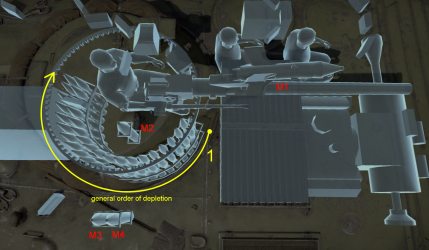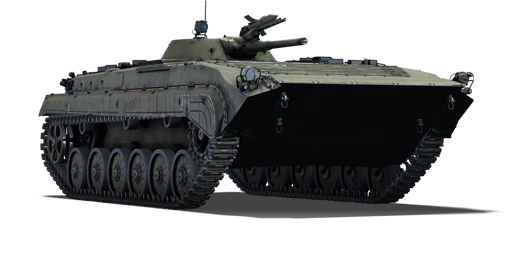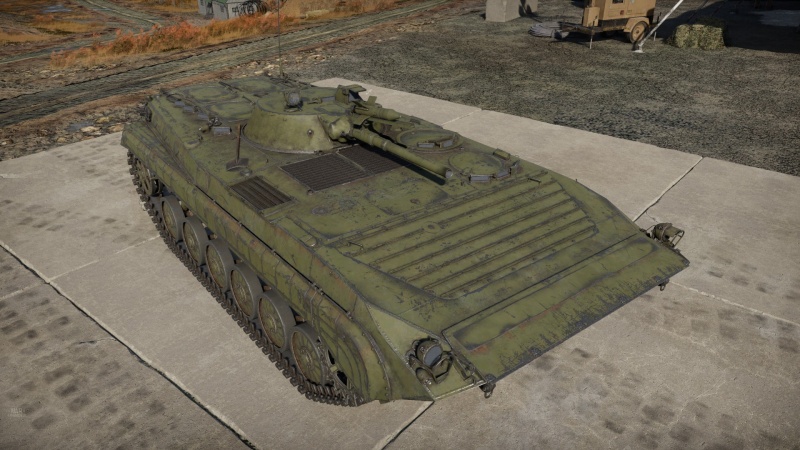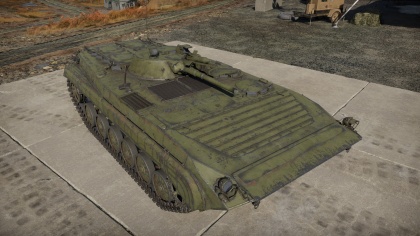Difference between revisions of "ZBD86"
(Edits) |
|||
| Line 1: | Line 1: | ||
| − | {{Specs-Card|code=cn_type_86}} | + | {{Specs-Card |
| + | |code=cn_type_86 | ||
| + | |images={{Specs-Card-Image|GarageImage_{{PAGENAME}}.jpg}} | ||
| + | }} | ||
== Description == | == Description == | ||
| Line 13: | Line 16: | ||
== General info == | == General info == | ||
=== Survivability and armour === | === Survivability and armour === | ||
| + | {{Specs-Tank-Armour}} | ||
<!-- ''Describe armour protection. Note the most well protected and key weak areas. Appreciate the layout of modules as well as the number and location of crew members. Is the level of armour protection sufficient, is the placement of modules helpful for survival in combat? If necessary use a visual template to indicate the most secure and weak zones of the armour.'' --> | <!-- ''Describe armour protection. Note the most well protected and key weak areas. Appreciate the layout of modules as well as the number and location of crew members. Is the level of armour protection sufficient, is the placement of modules helpful for survival in combat? If necessary use a visual template to indicate the most secure and weak zones of the armour.'' --> | ||
| Line 38: | Line 42: | ||
=== Mobility === | === Mobility === | ||
| + | {{Specs-Tank-Mobility}} | ||
<!-- ''Write about the mobility of the ground vehicle. Estimate the specific power and manoeuvrability, as well as the maximum speed forwards and backwards.'' --> | <!-- ''Write about the mobility of the ground vehicle. Estimate the specific power and manoeuvrability, as well as the maximum speed forwards and backwards.'' --> | ||
| Line 45: | Line 50: | ||
Be aware when attempting flanking maneuvers and early pushes that there are vehicles with better mobility characteristics, and in many cases you'll encounter a vehicle before reaching a desirable position. | Be aware when attempting flanking maneuvers and early pushes that there are vehicles with better mobility characteristics, and in many cases you'll encounter a vehicle before reaching a desirable position. | ||
| + | |||
| + | === Modifications and economy === | ||
| + | {{Specs-Economy}} | ||
== Armaments == | == Armaments == | ||
| + | {{Specs-Tank-Armaments}} | ||
=== Main armament === | === Main armament === | ||
| + | {{Specs-Tank-Weapon|3}} | ||
<!-- ''Give the reader information about the characteristics of the main gun. Assess its effectiveness in a battle based on the reloading speed, ballistics and the power of shells. Do not forget about the flexibility of the fire, that is how quickly the cannon can be aimed at the target, open fire on it and aim at another enemy. Add a link to the main article on the gun: <code><nowiki>{{main|Name of the weapon}}</nowiki></code>. Describe in general terms the ammunition available for the main gun. Give advice on how to use them and how to fill the ammunition storage.'' --> | <!-- ''Give the reader information about the characteristics of the main gun. Assess its effectiveness in a battle based on the reloading speed, ballistics and the power of shells. Do not forget about the flexibility of the fire, that is how quickly the cannon can be aimed at the target, open fire on it and aim at another enemy. Add a link to the main article on the gun: <code><nowiki>{{main|Name of the weapon}}</nowiki></code>. Describe in general terms the ammunition available for the main gun. Give advice on how to use them and how to fill the ammunition storage.'' --> | ||
{{main|2A28 (73 mm)}} | {{main|2A28 (73 mm)}} | ||
| Line 121: | Line 131: | ||
=== Additional armament === | === Additional armament === | ||
| + | {{Specs-Tank-Weapon|2}} | ||
| + | {{Specs-Tank-Weapon|1}} | ||
<!-- ''Some tanks are armed with several guns in one or more turrets. Evaluate the additional weaponry and give advice on its use. Describe the ammunition available for additional weaponry. Give advice on about how to use them and how to fill the ammunition storage. If there is no additional weaponry remove this subsection.'' --> | <!-- ''Some tanks are armed with several guns in one or more turrets. Evaluate the additional weaponry and give advice on its use. Describe the ammunition available for additional weaponry. Give advice on about how to use them and how to fill the ammunition storage. If there is no additional weaponry remove this subsection.'' --> | ||
{{main|HJ-73|HJ-73E}} | {{main|HJ-73|HJ-73E}} | ||
| Line 194: | Line 206: | ||
=== Machine guns === | === Machine guns === | ||
| + | {{Specs-Tank-Weapon|4}} | ||
<!-- ''Offensive and anti-aircraft machine guns not only allow you to fight some aircraft but also are effective against lightly armoured vehicles. Evaluate machine guns and give recommendations on its use.'' --> | <!-- ''Offensive and anti-aircraft machine guns not only allow you to fight some aircraft but also are effective against lightly armoured vehicles. Evaluate machine guns and give recommendations on its use.'' --> | ||
{{main|PKT (7.62 mm)}} | {{main|PKT (7.62 mm)}} | ||
Revision as of 09:44, 28 December 2020
Contents
Description
The ZhuangJia BuBing LÜDai 86 is a rank Chinese light tank
with a battle rating of (AB), (RB), and (SB). It was introduced in Update 1.91 "Night Vision".
A Chinese variant of the BMP-1, the ZBD86 is almost identical to the original Soviet version when stock, aside from the lack of rolled up canvas on the turret sides. But this vehicle has a hidden secret: as of Update "Raining Fire", the ahistorical BMP-1P modification has been replaced with the "ZBD86 Late". This equips it with the HJ-73E ATGM, a very powerful derivative of the original "Malyutka" with SACLOS control and a tandem warhead. As the ZBD86 is currently the last Chinese light tank in the game, the HJ-73E allows it to remain useful even when brought to higher tiers.
The ZBD86 is a shoot-and-scoot type of vehicle as an exposed ZBD86 is a dead ZBD86 - avoid being a target at all costs. Use your mobility to find reasonable sniping spots (for your ATGM) and only use your cannon if an enemy is close and unaware of your presence. Remember that if anything sees you, it can destroy you - even a .50 cal will make quick work of the ZBD86 from the sides or back.
General info
Survivability and armour
The ZBD86 has very little to speak of in the armour department. Minimal frontal and nearly non-existent side armour results in the vehicle being vulnerable to almost any incoming fire. As such, the vehicle's survivability stems entirely from its mobility and reasonably small profile. Where possible, utilise hills or other cover, only exposing as much of the vehicle as is necessary to engage an unaware target.
Despite the lack of armour, however, the ZBD86 will, on occasion, survive hits unexpectedly - the internals of the vehicle are largely non-critical and many rounds will over-penetrate.
| Armour | Front (Slope angle) | Sides | Rear | Roof |
|---|---|---|---|---|
| Hull | 7-12 mm (80°) Front glacis 19 mm (56°) Lower glacis |
16 mm (3-18°) Top 18 + 4 mm Bottom |
16 mm (12°) Top 12 mm (48°) Bottom 12 mm (8-51°) Doors |
6 mm 5 mm Engine exhausts |
| Turret | 23 mm (0-53°) Turret front 33 + 26 mm Gun mantlet |
13-23 mm (24-37°) | 13 mm (23-26°) | 6 mm |
| Armour | Sides | Roof | ||
| Cupola | 7 mm | 7 mm |
Notes:
- Suspension wheels and tracks are 10 mm thick.
- Belly armour is 6 mm thick.
Mobility
| Game Mode | Max Speed (km/h) | Weight (tons) | Engine power (horsepower) | Power-to-weight ratio (hp/ton) | |||
|---|---|---|---|---|---|---|---|
| Forward | Reverse | Stock | Upgraded | Stock | Upgraded | ||
| Arcade | Expression error: Unexpected * operator. | 465 | Expression error: Unexpected round operator. | __.__ | |||
| Realistic | 265 | Expression error: Unexpected round operator. | __.__ | ||||
The ZBD86's mobility is reasonably good, although somewhat lacking relative to other IFVs. Despite that, once it gets moving it can travel at a decent pace.
Be aware when attempting flanking maneuvers and early pushes that there are vehicles with better mobility characteristics, and in many cases you'll encounter a vehicle before reaching a desirable position.
Modifications and economy
Armaments
Main armament
The 2A28 main cannon is a somewhat finicky weapon. The penetration of the PG-9 HEAT round is no higher than the Type 62's HEAT-FS but the muzzle velocity of 665 m/s is lower, making it difficult to use at long range. Still, the gun reloads in only 6 seconds and has an autoloader. It can be quite lethal at close quarters with careful aim. Keep in mind that the ZBD86 does not feature any sort of stabilisation at all, and due to its light weight the gun is near impossible to get on target at speed.
There is essentially no reason to use the HE round. Its muzzle velocity is an abysmal 290 m/s and it actually has less explosive content than the HEAT round.
| 73 mm 2A28 | Turret rotation speed (°/s) | Reloading rate (seconds) | |||||||||||
|---|---|---|---|---|---|---|---|---|---|---|---|---|---|
| Mode | Capacity | Vertical | Horizontal | Stabilizer | Stock | Upgraded | Full | Expert | Aced | Stock | Full | Expert | Aced |
| Arcade | 40 | -4°/+30° | ±180° | N/A | 19.04 | 26.35 | 32.00 | 35.39 | 37.65 | 6.00 | 6.00 | 6.00 | 6.00 |
| Realistic | 11.90 | 14.00 | 17.00 | 18.80 | 20.00 | ||||||||
Ammunition
| Penetration statistics | |||||||
|---|---|---|---|---|---|---|---|
| Ammunition | Type of warhead |
Penetration @ 0° Angle of Attack (mm) | |||||
| 10 m | 100 m | 500 m | 1,000 m | 1,500 m | 2,000 m | ||
| PG-9 | HEAT | 300 | 300 | 300 | 300 | 300 | 300 |
| OG-9 | HE | 11 | 11 | 11 | 11 | 11 | 11 |
| Shell details | |||||||||
|---|---|---|---|---|---|---|---|---|---|
| Ammunition | Type of warhead |
Velocity (m/s) |
Projectile Mass (kg) |
Fuse delay (m) |
Fuse sensitivity (mm) |
Explosive Mass (TNT equivalent) (g) |
Ricochet | ||
| 0% | 50% | 100% | |||||||
| PG-9 | HEAT | 665 | 2.6 | 0.05 | 0.1 | 1,130 | 65° | 72° | 77° |
| OG-9 | HE | 290 | 3.7 | 0 | 0.1 | 735 | 79° | 80° | 81° |
Ammo racks

| Full ammo |
1st rack empty |
Visual discrepancy |
|---|---|---|
| 40 | 1 (+39) | No |
The single ammunition rack consists of a shell barillet located around the turret basket.
Additional armament
HJ-73
The ZBD86 comes with a rail-mounted manually-guided ATGM as stock, initially aimed manually and with somewhat mediocre penetration and explosive mass values. While occasionally useful, generally the main gun is easier and more reliable to use.
4 x HJ-73 ATGM
- Guidance type: MCLOS
- Firing range: 3 km
HJ-73E
Once the ZBD-86 Late upgrade is researched, the HJ-73 ATGM is replaced with a HJ-73E. Despite the new ATGM retaining the rail-mount, it is significantly more powerful and easier to use due to its semi-automatic guiding system. It penetrates more than twice as much as the original HJ-73 due to the tandem-charge warhead, at the cost of a decrease in explosive mass. This will go clean through almost any target that the ZBD86 can encounter, even those equipped with ERA or composite armor. It has enough penetration to go through the turret cheek of the basic M1 Abrams!
Keep in mind that the ATGM can only be fired when stopped or at extremely low speeds. It also travels more slowly at 130 m/s compared to the 205 m/s of the BMP-1P's 9M113 ATGM.
4 x HJ-73E ATGM (ZBD-86 Late)
- Guidance type: SACLOS
- Firing range: 3 km
Ammunition
| Penetration statistics | |||||||
|---|---|---|---|---|---|---|---|
| Ammunition | Type of warhead |
Penetration @ 0° Angle of Attack (mm) | |||||
| 10 m | 100 m | 500 m | 1,000 m | 1,500 m | 2,000 m | ||
| HJ-73 | ATGM | 400 | 400 | 400 | 400 | 400 | 400 |
| HJ-73E | ATGM (tandem) | 900 | 900 | 900 | 900 | 900 | 900 |
| Shell details | |||||||||
|---|---|---|---|---|---|---|---|---|---|
| Ammunition | Type of warhead |
Velocity (m/s) |
Projectile Mass (kg) |
Fuse delay (m) |
Fuse sensitivity (mm) |
Explosive Mass (TNT equivalent) (g) |
Ricochet | ||
| 0% | 50% | 100% | |||||||
| HJ-73 | ATGM | 120 | 10.90 | N/A | 0.1 | 2,600 | 80° | 82° | 90° |
| HJ-73E | ATGM (tandem) | 130 | 12.50 | 0.2 | 0.1 | 1,830 | 80° | 82° | 90° |
Ammo racks

| Full ammo |
1st rack empty |
2nd rack empty |
Visual discrepancy |
|---|---|---|---|
| 4 | 3 (+1) | 1 (+3) | No |
The missiles are listed from M1 to M4. M2 is the 1st rack. M3-M4 constitutes the 2nd rack.
Machine guns
The ZBD86 comes equipped with a coaxial 7.62 mm PKT machine gun. This is only useful for clearing small obstacles or exposed crew in open-top vehicles.
| 7.62 mm PKT | ||||
|---|---|---|---|---|
| Mount | Capacity (Belt) | Fire rate | Vertical | Horizontal |
| Coaxial | 2,000 (1,000) | 700 | N/A | N/A |
Usage in battles
The ZBD86, just like the BMP-1, is quite distinctive due to its oddly-shaped hull. The vehicle is crewed by only three (no commander), but is very spacious, so shots from the side occasionally cause minimal or even no damage. However, with only 23 mm AT MOST protecting the tank, it's a safe bet that hull breaks will be plentiful, especially when facing enemies equipped with APFSDS or HEAT. The ZBD86 is equipped with a short-barreled 73 mm gun (an odd calibre) firing exclusively anti-tank grenades. The projectile drop is extreme, albeit not the worst in-game, and it can be used to great effect against many of the vehicles the ZBD86 will face due to the consistent 300mm of penetration at range. The standard PG-9 ammunition has an explosive mass of about 1.25 kg. The trade-off, in this case, is the low velocity and relatively poor slope characteristics (the penetration drop in half if more than 60 degrees of slope). Finally, as standard, the ZBD86 is equipped with the 9M14 ATGM, capable of penetrating 400mm and carrying an explosive mass of 2.6 kg. It is WASD guided, and therefore somewhat tricky to use at first (and especially difficult to use in high packet-loss or high ping matches). An optional modification for the ZBD86 allows it to use turret-mounted smoke grenades as well as a next-generation missile, the 9M113. The ZBD86 (as of 1.77.2.149) is the earliest vehicle in-game to be able to use a SACLOS (mouse-guided) system for an ATGM. Not only is the missile nearly twice as fast as the 9M14, but it carries a notably larger explosive payload, and can penetrate up to 600 mm at 90 degrees at any range. As of 1.91, the ZBD86 can research NVD, which can help during night battles to help with visibility. NVD is available in commander, gunner, driver and outside viewports. Once purchased, the NVD modification also allows the use of a Infrared Spotlight to help illuminate targets if they are hard to see. However, it is mounted to the hull, and as such will require the hull to be rotated to illuminate anything.
Modules
| Tier | Mobility | Protection | Firepower | ||
|---|---|---|---|---|---|
| I | Tracks | Parts | Horizontal Drive | NVD | |
| II | Suspension | Brake System | FPE | Adjustment of Fire | Airstrike |
| III | Filters | Crew Replenishment | Elevation Mechanism | ZBD86 Late | |
| IV | Transmission | Engine | ESS | Artillery Support | Improved optics |
The modules and stock grind of the ZBD86 are very similar to the BMP-1. Note that the ZBD86 Late modification upgrades the ATGM and adds smoke grenades, as on the BMP-1P, but does not remove the autoloader.
Pros and cons
Pros:
- Good mobility
- One of the earliest ATGM vehicles available and the earliest to receive mouse-guided (SACLOS) ATGMs
- Amphibious ability allows it to reach positions that other vehicles struggle to
- Functional even in uptiers due to its high-penetrating ATGMs and HEAT rounds
- All ammunition types are default and as such have no cost
- HJ-73E ATGM has extremely high penetration for its rank, to the point of overkill
- Night vision allows it to be used in night battles
Cons:
- Mediocre reverse speed, particularly for a light tank
- Vulnerable to hull breaks, particularly from HEAT-FS rounds
- Chemical ammunition only, may struggle to damage vehicles with ERA like the M60A1 RISE (P) without the HJ-73E
- All available ammunition is hyper-sensitive and will detonate on hitting light obstacles such as fences or bushes
- Somewhat large silhouette for a light tank
- Poor gun depression
- No stabilizer
- Only three crew members, the commander and driver are clustered together
- Vulnerable to heavy machine gun and light cannon fire, particularly from the sides or top
- Very vulnerable to aircraft, helicopters, and artillery
- Infrared spotlight mounted to hull, won't rotate with turret when NVD is on
- HJ-73E is tilted upwards which severely limits its close quarter combat capacity as the missile cannot hit targets too close
History
Development
In the 1950's, Soviet armored personnel carrier (APC) tactics consisted of lightly armored vehicles that would transport soldiers to combat zones, and then head back behind the lines to safety. During this time, the West German Bundeswehr was using the Schützenpanzer Lang and infantry fighting vehicle (IFV) tactics, where the vehicles would work with the infantry and tanks in order to support them, especially against lightly armored targets. The BMP was a Soviet IFV design created in the late 1950's. Some of the requirements were the ability for all of the infantry carried to be able to fire from within the vehicle, which was unseen before in IFV designs. It was intended to support the infantry and combat enemy light vehicles. The design placed emphasis on speed and maneuverability, potent armament, and sufficient armament to protect against 23 mm autocannons over the frontal arc. There was a debate over how the vehicle should be wheeled or tracked, and a number of options were explored including hybrid designs with both. The design that was chosen was a tracked vehicle with the engine in the front and the crew compartment in the rear; it was designated the Object 764. A prototype was created in 1964, and the final design was chosen in 1965 - an improved model called the Object 765. In service the production model was called the BMP-1.
Design
The BMP-1 features a fully tracked hull, with a sharply angled glacis at the front, a centrally mounted turret, and a crew compartment in the rear of the hull, with doors for the infantry to mount and dismount the vehicle. The hull layout is as follows: the engine was in the front right section of the hull. The driver sat to the front left of the vehicle, the commander sat right behind the driver, and the gunner sat in the right side of the turret. The troop compartment located at the rear of the vehicle could seat 8 infantry soldiers. The ability to fire from inside the vehicle was provided by four firing ports on each side of the hull and one in the left door. There are also four hatches in the roof. The infantry sit on two benches with padding, back to back, facing the outer sides of the vehicle. The armor of the frontal arc is enough to generally protect against 20 mm autocannon fire, the side armor generally protects against 12.7 mm machine gun fire, and the roof and rear armor protects against small arms fire and shell fragments. In addition, the sloped glacis on the front of the hull also increased the chances of shells bouncing, because of the extreme angles. The protection level depended somewhat on the version of the BMP-1 in question, as different nations had differing levels of armor quality. The main armament consisted of a 73 mm 2A28 Grom smoothbore semi-automatic cannon, along with a 9M14 Malyutka anti-tank guided missile (ATGM). Secondary armament consisted of a 7.62 mm PKT machine gun. The engine provides 300 hp, and is a six-cylinder four-stroke diesel engine. The suspension system used was a torsion bar suspension system. The BMP-1 is fully amphibious with little preparation. Before entering the water a trim vane has to be raised, which provides additional frontal armor when in the lowered position. It can achieve 65 kph (40 mph) on road and 8 kph (5 mph) in water.
Production and Service
Over 20,000 BMP-1's were produced in the Soviet Union alone, with many more produced in China and Czechoslovakia. The BMP-1 was widely exported and saw significant combat worldwide. BMP-1's participated in the Yom Kippur War, the Angolan Civil War, the Iran-Iraq War, the Gulf War, and many other conflicts. It was well liked for its maneuverability, but it was found that the cannon lacked effective range and the 9M14 ATGM's were hard to control. During the Gulf War it was found that the 25 mm Bushmaster cannon found on the M2/M3 Bradley could consistently penetrate the frontal armor of the BMP-1, even at range.
BMP-1P Upgrade
The BMP-1P was an upgrade to the ATGM systems of the BMP-1. It replaced the 9M14 Malyutka missiles with 9M113 Konkurs or 9M111 missile. This increased the weight of the vehicle, leading to a slight decrease in maneuverability.
Chinese Service
China produced their own version of the BMP-1 called the ZBD 86, also known as Type 86. They produced a total of over 3,000 Type 86 vehicles of different variants. Over 1,000 are still in service today.
Media
- Skins
- Videos
See also
Links to the articles on the War Thunder Wiki that you think will be useful for the reader, for example:
- reference to the series of the vehicles;
- links to approximate analogues of other nations and research trees.
External links
Bibliography
- David B. (2015, December 1). BMP-1. Tank Encyclopedia. https://tanks-encyclopedia.com/coldwar/USSR/soviet_BMP-1.php
- BMP-1. (2020, March 25). In Wikipedia. https://en.wikipedia.org/w/index.php?title=BMP-1&oldid=947316322
| China light tanks | |
|---|---|
| Type 63 | Object 211 · Type 63 · ZTS63 |
| Type 62 | Type 62 |
| WZ551 | ZSL92 · PTL02 · WMA301 |
| ZBL08 | ZLT11 |
| Type 86 | ZBD86 |
| WZ502 | ZBD04A |
| ROC | M41D · M64 |
| Type 59 | QN506 |
| USA | ␗M8 LAC · ␗M3A3 Stuart · ␗M3A3 (1st PTG) · ␗M5A1 · ␗M24 · ␗M18 GMC · ␗M41A3 |
| USSR | ␗T-26 · T-26 No.531 · ␗PT-76 |






